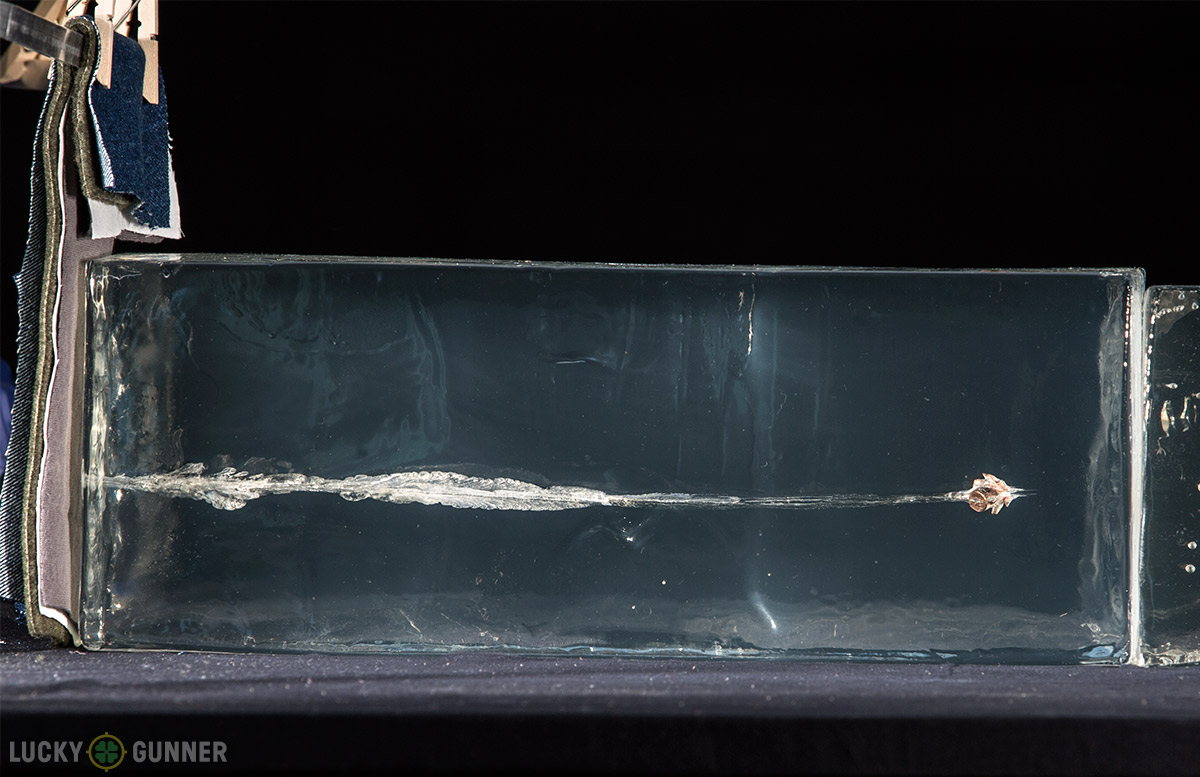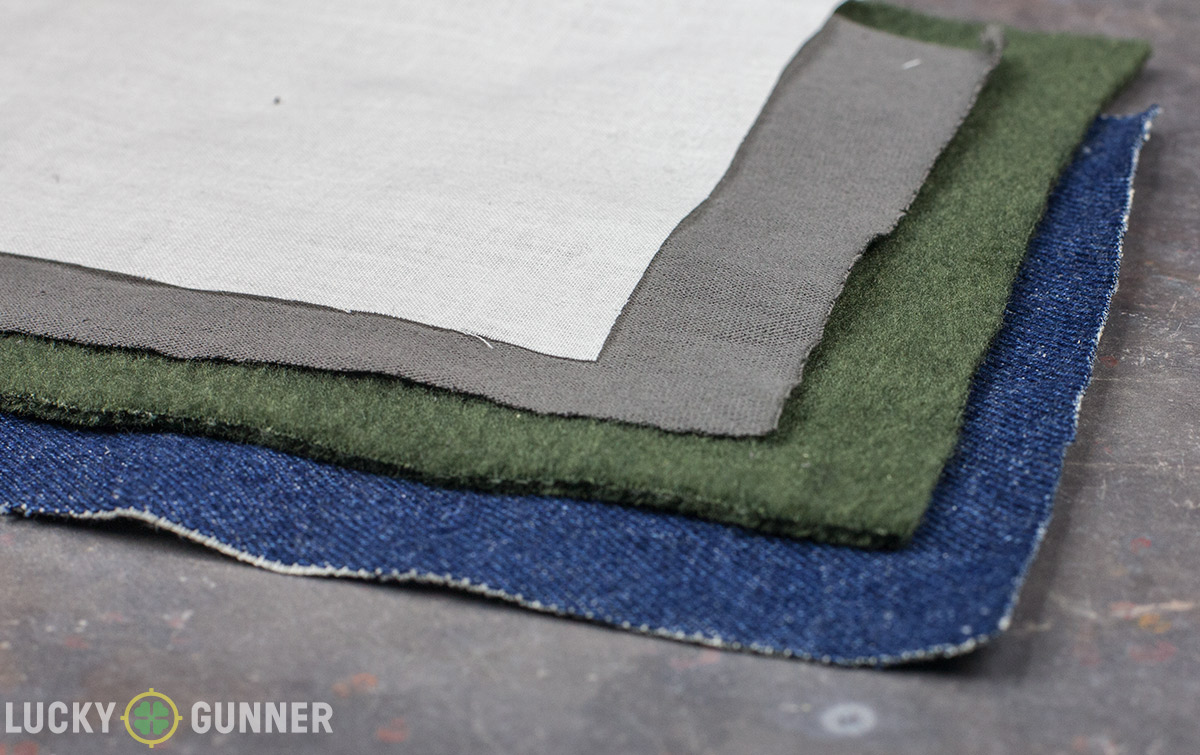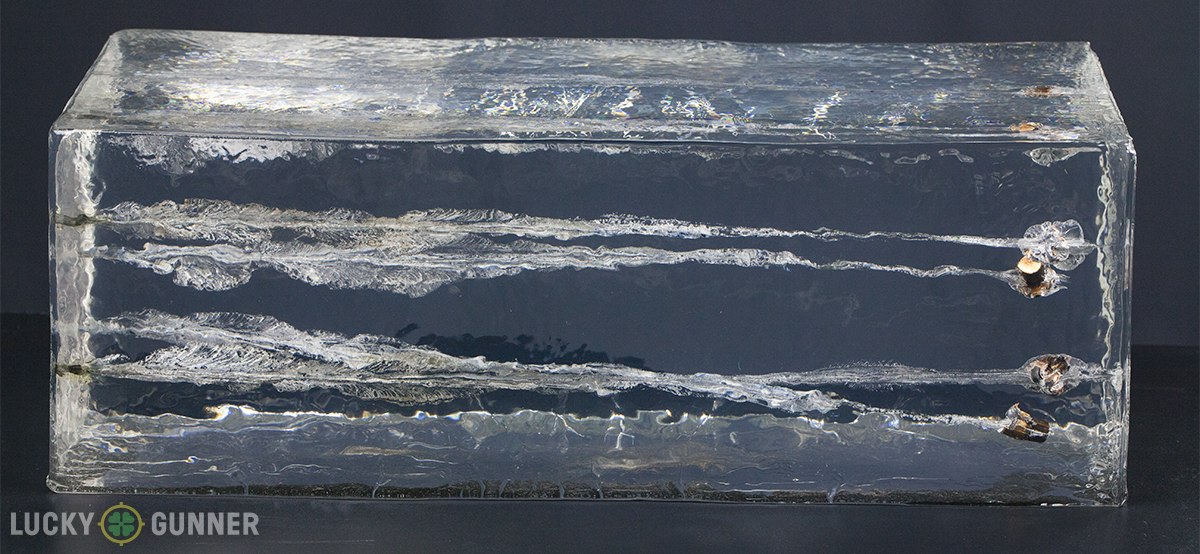by Woodsbum
Gunguy sent me a link that I felt compelled to included here. Of course there are thousands of articles on this subject, most of which contradict all the other articles out there. The interesting thing about this one is that it downplays ALL handgun cartridges and calibres as “sucking.” This was the first time I have seen someone take the stance on handguns in the use of self defense. It truly shocked me that there was no underlying .40 cal fanboy tone or a shadowed “.45 auto is the greatest round ever created.”
Now, please remember that I did not write this article. I have merely linked it and copied it here for ease of your reading. There are some additional charts on their webpage that show the results of various loads, bullets, etc. If you want that detail, please check out the article on Lucky Gunner.
*****************************************************************************
Project Summary
Over the last few months, I’ve been working with the rest of the Lucky Gunner team on another one of our epic experiments, which we’re proud to finally unveil: ballistics gelatin testing for over 100 self-defense handgun ammunition loads. 117 to be precise, and that’s just round one. This testing will be ongoing, and we’ll keep adding to the results as we have the chance to test more loads.
If you came here just to see the data from our tests, you can use the handy menu above to skip right to the results section. If this whole ballistics testing thing is new to you, or you want to know more about our process, then you might want to keep reading. If you’re more of a “bottom line” kind of person, you can skip over both the setup and the test results and check out the conclusions section. However you use this information, we hope you find it helpful when picking out your next self-defense load.
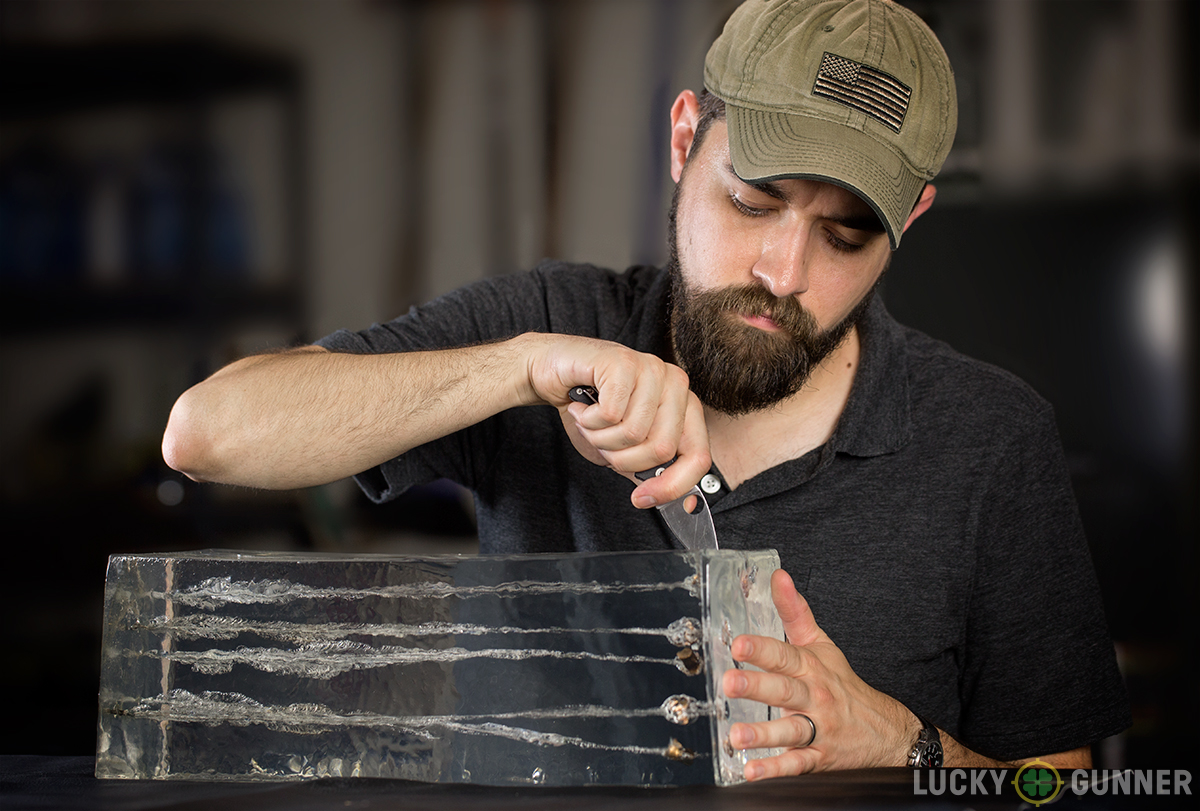
Ballistics Testing in Plain English
The science of wound ballistics can be a daunting topic, especially if you’re not inclined to use your leisure time to study physics and anatomy. At the end of the day, it’s really just the study of how and why bullets inflict damage. That sounds fairly straightforward, but even experts who study this for a living can’t seem to all agree when it comes to the effectiveness of handgun ammo.
The reason for this lack of consensus is simple: handguns suck. If someone wants to kill you, and the only way to prevent that from happening is to shoot them, a handgun is far from the ideal firearm to use — they just happen to be the type of firearm we’re most likely to have immediate access to. Contrary to what Hollywood has ingrained into our consciousness, shooting bad guys with pistols doesn’t make them fly backwards through the air, crashing into a bloody, motionless heap. In reality, the effects of wounds from handguns are unpredictable and often not very dramatic. So the study of handgun wound ballistics is not always clear cut, and any speculation we can make about how a given self-defense load will perform in the real world will be, at best, an educated guess.
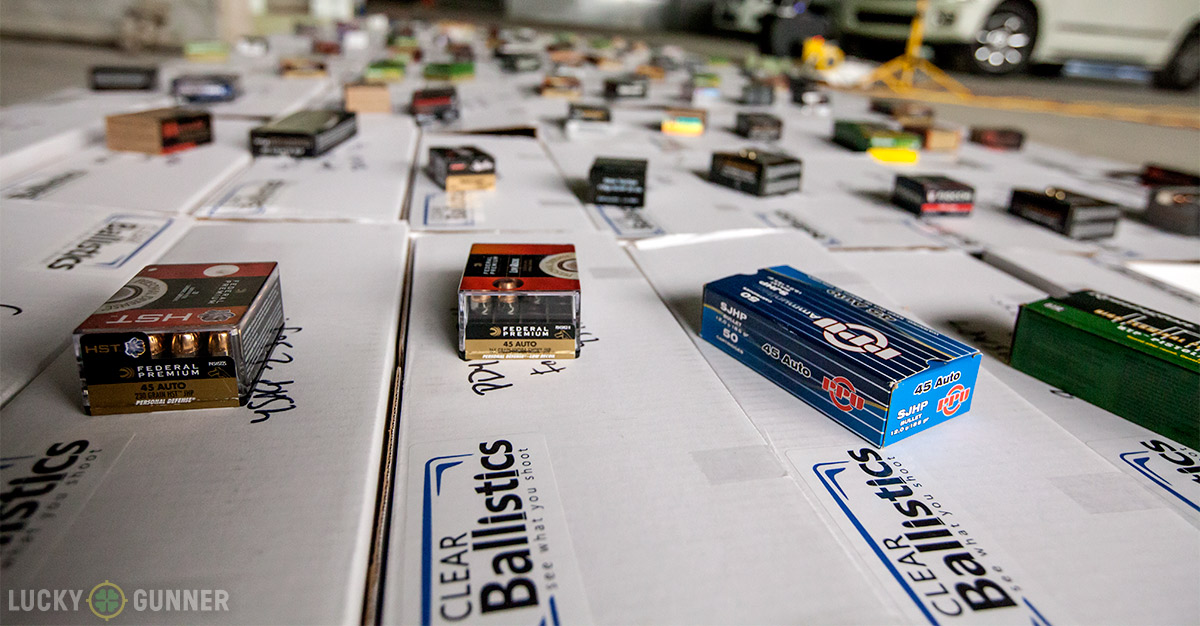
Bullets fired from handguns do only one thing: poke little holes in stuff. If the little hole doesn’t go through something that’s important for a human being’s body to remain upright and functioning, that person can still go about their business, which may include trying to hurt other people.
Of course, sometimes violent attackers give up or flee before shots are actually fired. When the mere sight of a gun in the hands of a would-be victim doesn’t do the trick, an assailant will often give up once fired upon, even if they haven’t sustained wounds that would cause their bodies to shut down right away. But these are examples of what Bob Ross would have called “happy little accidents”. It’s great if the bad guy gives up, but we can’t count on that happening. We have a gun to prepare for the worst, and in the worst kind of violent attacks, the bad guy doesn’t give up until he is physically incapable of doing you harm.
So with that in mind, a handgun can quickly and definitively stop a determined attacker only if two conditions are met:
- The gun must be fired at a so-called “vital area” of the attacker. This usually means the heart or the brain/spine. Hits to the lungs and other organs can also be effective, but results may be slower.
- The bullet must have the ability to penetrate whatever is between the muzzle and those vital organs in order to disrupt their function — for non-uniformed civilians, this typically includes clothing, tissue, and bone.
That’s it. No matter what else may happen during the course of a lethal confrontation, if you shoot the guy in the right spot with a bullet that penetrates deep enough, the threat will go down.
The first condition depends on the person operating the gun. No amount of bullet technology can make up for a miss. But as for the second condition — how do we know if the ammo we have in our self-defense gun is up to the task?
Conventional wisdom says to use ammunition with a hollow point bullet. These bullets are designed to expand upon impact with soft tissue. The expansion deforms the bullet and increases its diameter, which increases the likelihood of the bullet hitting something vital inside the target. Commercial hollow point technology is decades old, and there are dozens of different bullet designs on the market for all of the popular handgun calibers. So aside from the marketing materials put out by the ammo manufacturers, how are we supposed to know which bullets are the most effective?
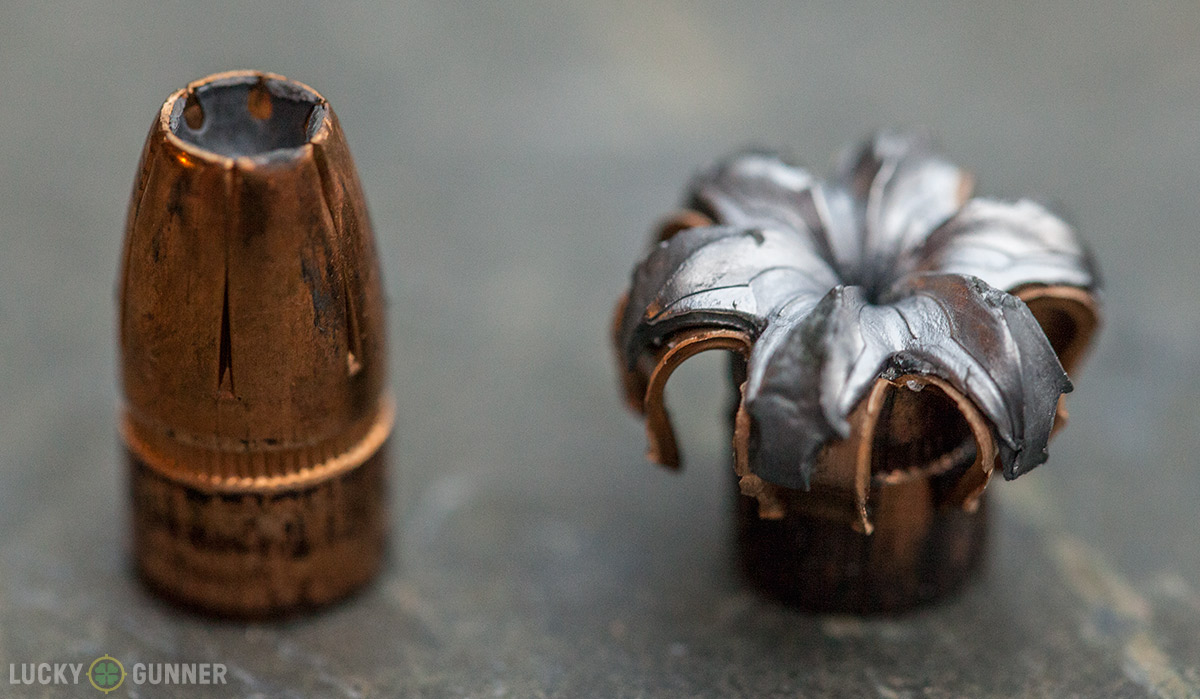
That’s where ballistic gelatin testing comes in. Back in the late 1980s, the FBI began to use blocks of gelatin made from a solution of water and a powdered form of miscellaneous animal parts — called “ordnance gelatin” or “ballistics gel” — as a substitute for living tissue for testing the effects of duty ammunition. Firing bullets into the gelatin gave them some idea of what the bullet could do inside a person — in particular, how deep the bullet could penetrate, and the degree to which the bullet might expand or deform.
Ordnance gelatin isn’t an exact simulation of living flesh. People and animals have skin, bones, tendons, and organs that are all different in terms of hardness and density. These variables can cause bullets to deflect, fragment, or otherwise behave in unpredictable ways. Conversely, ordnance gelatin is homogeneous, and free of internal obstructions, so the way a bullet behaves in gelatin is indicative of a real life best case scenario. Bullets will not always provide the same results on living tissue that we see in gelatin, but we can expect bullets that perform poorly in gelatin to have a lower success rate on humans, and bullets that perform well in gelatin are more likely to overcome some of the unpredictable variables encountered in the real world.
The other advantage of using a consistent medium like gelatin is that it allows for an “apples to apples” comparison between ammo loads. Each block of gelatin has the same physical properties, so bullet A fired into block A can be compared to bullet B fired into block B. This provides a much more scientific and objective method for comparing ammunition loads than anecdotal reports from real life shootings where there are a plethora of unknown variables to consider.
Today, this type of testing is made even easier with the advent of synthetic ballistic materials. The “real” organic ballistics gelatin blocks used by the FBI today are still made from dehydrated animal tissue. They provide accurate results, but they’re time consuming to make and they have to be refrigerated until almost immediately before they are used. And after all of that, the fired bullets are difficult to see through the cloudy, mud-colored organic gelatin.
Synthetic gelatin from the company Clear Ballistics is temperature stable up to 240° F, so the blocks can be shipped directly to the end user without melting or deforming. These blocks are also completely transparent, so the test results can be observed without cutting into the block. Test results using Clear Ballistics blocks come very close to results using organic gelatin, at least for comparing the penetration and expansion properties of handgun bullets. In addition, the convenience of working with the synthetic gelatin allows testing on a scale that is not practical with a substance as delicate and labor-intensive as traditional organic ordnance gelatin.
Lucky Gunner Ballistic Testing Standards
The goal of our project is to test as many loads as possible in order to determine how they compare to the FBI standard recommended penetration depth of 12-18″. We also want to know how well the bullets expand when they encounter a barrier of heavy clothing before entering the gel. Whenever feasible, we tried to duplicate the testing protocol reportedly used by the FBI, but our first priority was to be consistent, using the same procedure and conditions for every load we tested.
We fired five rounds of each self-defense load using short-barreled pistols positioned 10 feet from a Clear Ballistics synthetic gelatin block with a four-layer heavy clothing barrier placed in front of it. The first shot of every test was filmed with a high speed camera, and we took high resolution photos of the gelatin blocks after the first and fifth shots of each load. We measured penetration depth and later, we recovered the fired bullets from the gelatin blocks, measured their diameter, and took additional photos.
Here’s a little more on how and why we set up our test this way.
Distance
Each shot was fired with the muzzle approximately 10 feet from the surface of the gelatin block. The FBI used to test handgun ammo at 20 yards as well as 10 feet, but they found very little difference in the data at these two distances. The current practice of the FBI is to use the 10 foot test for handgun ammo, and that’s what we’ve followed here.
Heavy Clothing Barrier
To get an idea of how a bullet will perform under various real world conditions, the FBI tests each load with a variety of barriers placed in front of the gelatin. They start with a plain block of “bare” gelatin with no barrier, and follow up that test with a barrier of heavy clothing, and then hard barriers of steel (to simulate an auto body), plywood, wallboard, and auto glass.
Because non-law enforcement self-defense shootings are highly unlikely to involve firing through walls or cars, the bare gelatin and heavy clothing tests are most relevant for the average civilian gun owner. In order to test as many loads as possible, we opted to skip over the bare gelatin testing and conducted all of our testing only with a heavy clothing barrier. Most of us train to fire at the vital zone or “center mass” high in the chest area of the target, which is an area typically covered by clothing.
The heavy clothing test simulates a scenario in which the target is wearing four layers of clothing: two cotton shirts, fleece, and denim. The FBI uses this standard not because it’s common for people to actually wear that exact clothing, but because they are common clothing materials, and when combined they represent something close to a worst case scenario for a bullet.
Clothing can present a challenge for some hollow point loads because the opening in the bullet can become clogged with clothing material and fail to expand once it reaches living tissue. This failure to expand gives the bullet a lower probability of striking a vital area, and also leads to the potential for over-penetration. Expanding bullets lose velocity quickly and are more likely to stay inside the target, but a hollow point that fails to expand can maintain enough energy to exit the target and potentially harm bystanders.
We used the same type of fabric specified in the FBI heavy clothing test, which calls for the following:
- cotton t-shirt material (approximately 5.25 ounces per yard, 48 threads per inch)
- cotton shirt material (approximately 3.5 ounces per yard, 80 threads per inch)
- Malden Mills Polartec 200 fleece
- cotton denim (approximately 14.4 ounces per yard, 50 threads per inch)
The four layers of fabric were stacked together and placed against the front of the gelatin block, secured with clothes pins to a bar suspended above the test block.
Five-Shot Trials
For every load tested, we fired five shots through the heavy clothing barrier into a fresh block of gelatin. This gave us multiple data points for each load, which turned out to be important since many loads did not exhibit the same performance from shot to shot. Clear Ballistics gelatin can be melted down and re-used, but we started with a factory-new block for every five-round test.
Gelatin Blocks
The Clear Ballistics blocks we used measure 6”x6”x16”. Since we knew many of the loads would penetrate deeper than 16”, we used two blocks placed end to end, giving us the ability to measure the depth of rounds that penetrated up to 32”. Any rounds that completely penetrated both blocks and continued into our backstop were simply marked as 32” in our data.

Short Barreled Handguns
This is one area where we intentionally deviated from the typical FBI test. Ballistics testing is most often conducted with full size or “service size” handguns with barrel lengths of at least 4”. However, most armed citizens carry smaller guns with shorter barrels, which means the bullets they fire will fly at a lower velocity than what is advertised by the ammo manufacturer. Ballistics data gathered using full size barrels can be misleading if applied to these small concealable pistols. We ran our tests with popular concealable handguns with barrel lengths we think are more representative of what the average citizen is actually carrying. The test guns used were as follows:
- .380 ACP: Glock 42, 3.25-inch barrel
- 9mm: Smith & Wesson M&P9c, 3.5-inch barrel
- .40 S&W: Glock 27, 3.42-inch barrel
- .45 ACP: Kahr CW45, 3.64-inch barrel
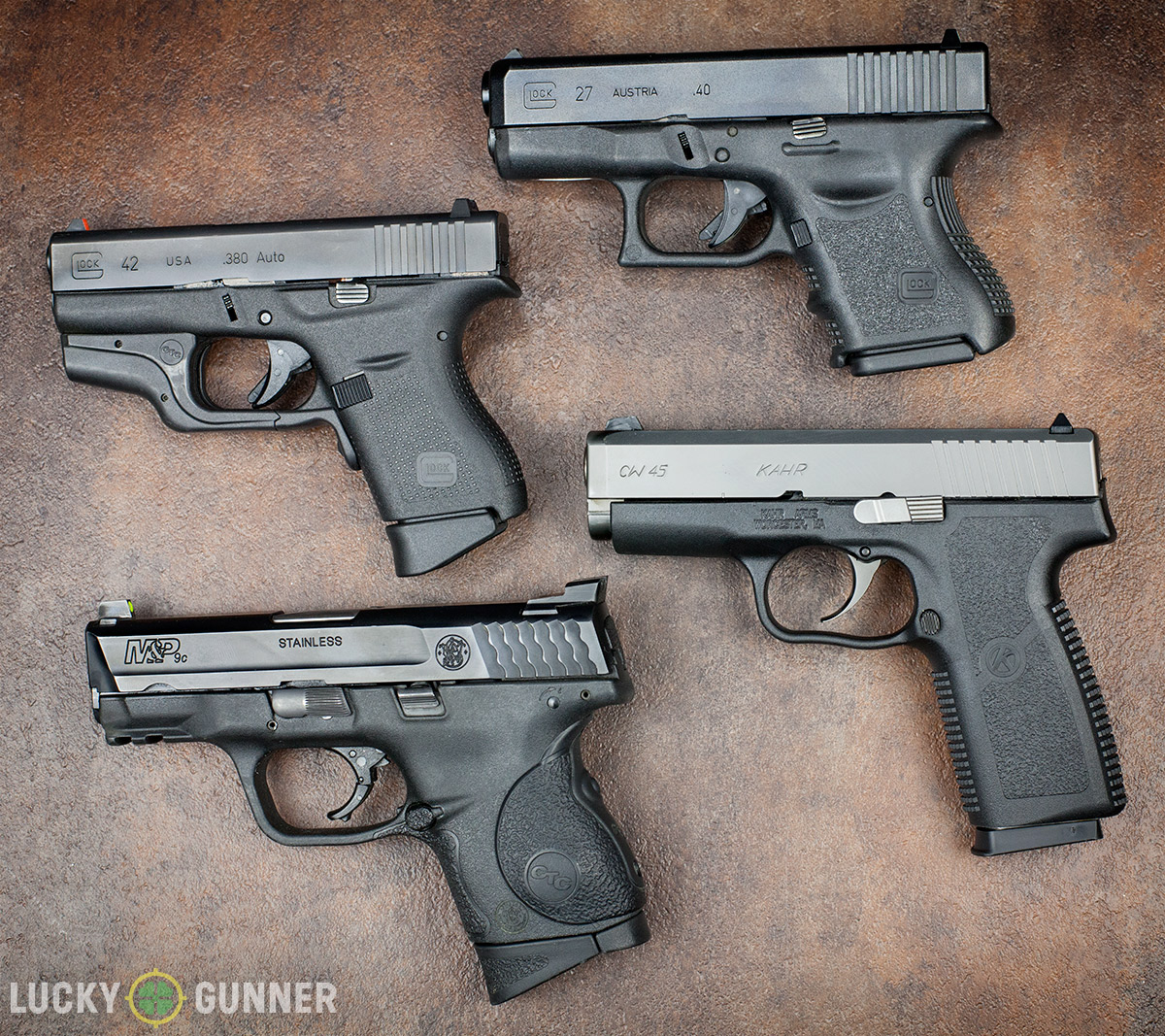
Measurement Methods
Penetration depth was measured from the face of the gelatin block to the farthest point of the bullet’s resting place. In cases where the bullet fragmented into multiple pieces, the depth of the largest fragment was the measurement taken.
In the photos of the gelatin blocks, you can see lines that appear to be a continuation of the wound channel that extends beyond the resting place of the bullet anywhere from 1/8″ to over 2″. From watching our high speed video footage, it’s clear these lines are the result of bullet “bounce back”. Once the bullet travels as far as it can go, the somewhat elastic properties of the Clear Ballistcs gelatin cause the bullet to “snap” backward slightly before coming to a complete stop. This same phenomenon occurs also occurs in organic gelatin, though the result is more difficult to see. These lines are typically ignored when measuring the penetration depth, and the farthest point of the bullet itself is what most other tests use to measure from.

After we recovered them from the gel blocks, the expanded bullets were measured with digital calipers. The deformed and expanded bullets are not perfectly round, so we measured them at their widest point. While this is the most practical way to measure bullet expansion, keep in mind that the numbers can be misleading. Bullets that deform inconsistently with a fragment of jacket protruding unevenly on one side could potentially measure the same at the widest point as a bullet that expands more uniformly, even though the latter may indicate a better potential for tissue damage. We recommend taking under consideration the measured diameter data and viewing the photos of the expanded bullets for consistency and uniformity.
High Speed Video
The first round fired for each load was recorded with a high speed camera at 10,000 frames per second. You can click on the name of the load in the chart to see this footage, as well as additional photos and more detailed data. Here’s an example from one of the 9mm Speer Gold Dot ammo tests.
So what can you do with this information? There are a lot of varying opinions on what to look for and what we can learn from ballistic gelatin testing, even among qualified experts. Our goal isn’t to tell you which loads to use or which ones are best. We have thrown in a few of our observations here and there, but we’re not out to make any definitive conclusions. Admittedly, none of us here on the Lucky Gunner team are experts in the science of wound ballistics — there is more that goes into professional ballistic gel analysis than measuring penetration and expansion.
However, this also wasn’t a haphazard back yard experiment we tackled on a bored Sunday afternoon. We went to great lengths to set up consistent testing conditions and follow the same procedure for every trial so we would achieve results that could be reliably compared to one another. We’re providing this information as a service to the shooting community because there are so few resources available to help consumers distinguish one hollow point load from the next other than the brand name and color of the shiny foil-embossed ammo box.
The data from our ballistic tests is presented below in four separate charts, divided by caliber. We’ve simplified and consolidated a lot of the data in order to highlight the most important information and to facilitate easy comparisons between loads. High speed video footage, detailed data, and additional photos can be found by clicking on the product name for each load.
Penetration Depth
The charts below show the average penetration depth of each five shot trial, and the graph displays a representation of each individual shot. Clicking on the graph (or the photo icon if you’re using a mobile screen that’s too narrow to display the graph) will display actual photographs of the gelatin block we fired.
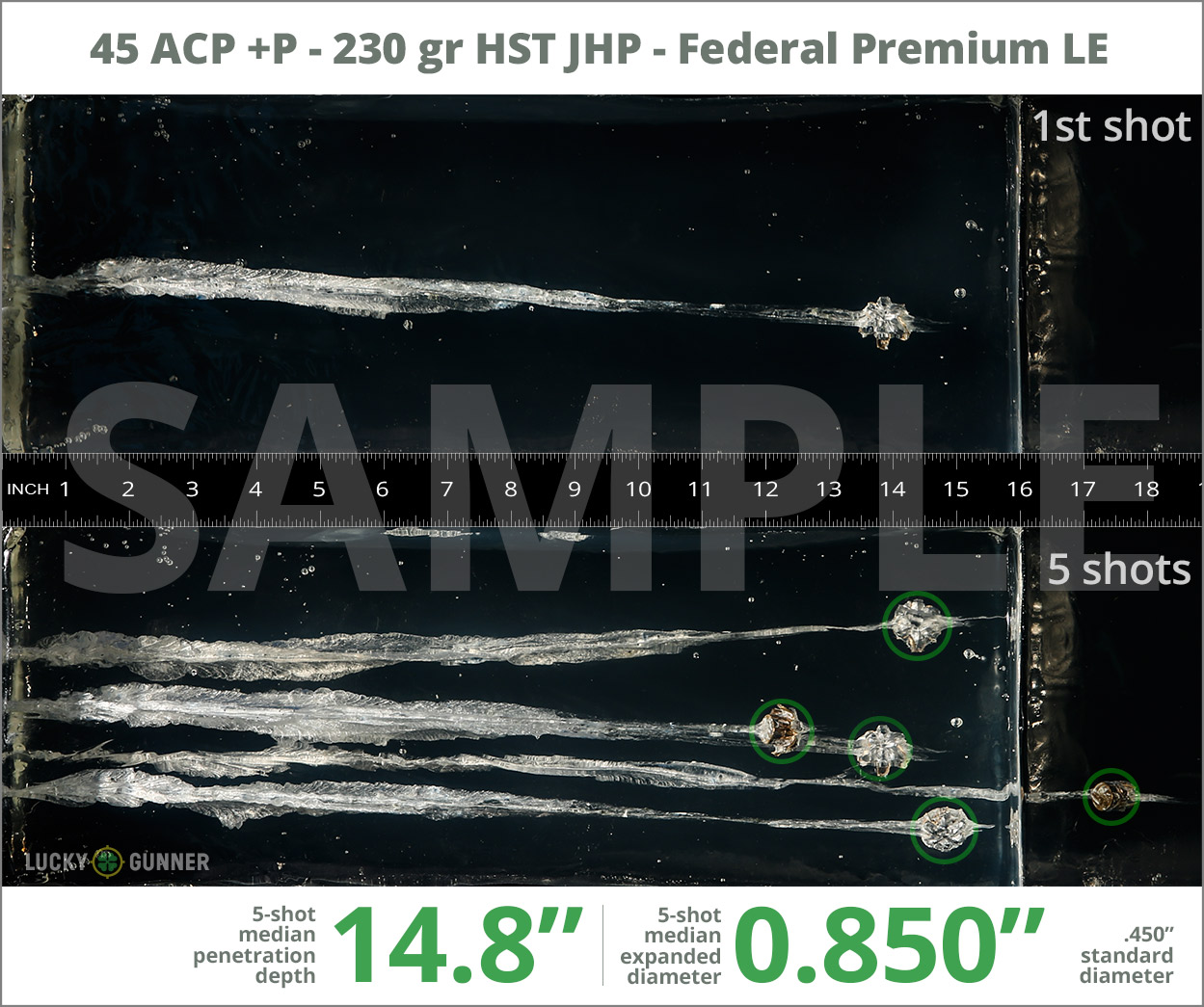
We aren’t ranking any of these test results ourselves, but if you’re looking for some standard to compare these findings to, you can start with the FBI protocol. Their standard requires duty ammo to penetrate between 12 inches and 18 inches in ballistic gelatin. We’ve highlighted this range in the penetration graph on our chart so you can easily see which loads came close to this standard, but that shouldn’t be read as a pass/fail test. We can’t assume that a load with any bullets falling outside of the 12″-18″ range should automatically be regarded as a total failure. Consider penetration, expansion, and weight retention, as well as consistency of a load from one bullet to the next. Also consider that the heavy fabric barrier we used is just one type of test, and results could vary for rounds fired into bare gelatin or hard barriers.
There may be some disagreement on the specifics of what to look for in these kind of tests, but you will find few advocates of ammo that penetrates significantly less than 12 inches, or expanding ammo that consistently fails to expand as designed. Consistent slight over-penetration (greater than 18″) is generally considered acceptable if the alternative is under-penetration, or inconsistent performance.
Why 12 inches?
The 18 inch maximum penetration depth standard makes sense to most people — too much penetration and the bullet can go clean through the target (possibly changing direction slightly before exiting) and onward to harm an unintended target. On the other hand, the 12 inch minimum penetration standard can be more confusing. If the bullet needs to reach the middle of the chest cavity where the organs are, wouldn’t we need a penetration depth less than half of that in most cases? Some of the reason for the 12 inch minimum standard is simply “playing it safe” and allowing for the possibility of attackers possessing greater than average girth. But part of the rationale is based on the simple reality of three-dimensional anatomy.
We typically imagine a potential attacker will be directly in front of us, facing our direction with squared shoulders, much like the paper and cardboard targets we usually use. But it should come as no surprise that this is not how gunfights usually go down. We have to account for a human target that may be turned slightly toward or away form us at an angle, or possibly even above or below us, or with arms partially obscuring the torso.
If you’re having a hard time picturing why this would affect the penetration depth necessary to reliably stop an attack, imagine you’ve just been ambushed by a 275 pound dude wielding a baseball bat. As he is rushing toward you, winding up the bat for a knockout blow, you manage to draw your pistol and fire a perfectly aimed shot at his upper chest. But since he’s in mid-swing, the bullet doesn’t go straight into his chest — it enters his arm just above the elbow and now has to pass through half an arm, a shoulder, a rib cage, and a lung in order to reach the heart or spine. A bullet that can penetrate only 9 inches might lodge in the guy’s rib; unpleasant for him, but not the definitive fight-stopping shot we want.
That’s a somewhat extreme example to illustrate the point, but it’s not an unrealistic scenario. These real life encounters are messy, and what constitutes “adequate” penetration in any given situation is not a universal constant. When ballistics experts have suggested changes to the 12 inch standard, it has only been in the direction of increasing that number, but for the time being, the FBI still deems the 12-18 inch penetration range to be ideal.
Expansion
For bullet expansion values, the chart shows you the average diameter of the five bullets fired and a photograph of the bullets retrieved from the gel block alongside an unfired bullet pulled from a cartridge in the same box of ammo.

Unlike penetration, there is no widely accepted minimum standard for expansion. One commonly used threshold is an expanded diameter at least 1.5 times the original diameter, but that’s far from universal. Most law enforcement agencies that have a minimum standard for duty ammo tend to prioritize penetration over expansion, and consistent expansion is often considered more important than a specific target minimum diameter.
Weight Retention
One final criteria to consider with self-defense handgun ammo is weight retention. This is essentially a way to measure the bullet’s ability to stay in one piece while travelling through barriers and tissue. This is not as much an issue with modern handgun ammunition as it was with older bullet designs, but a few of our test loads did show a tendency to fall apart in the gelatin. This occurred for one of two reasons: separation of the jacket and bullet core, or a bullet that is intentionally designed to fragment on impact. Fragmenting bullet designs are common in high velocity rifle loads, but not nearly as popular in handgun ammo, though more companies have recently begun to produce them. In our tests, these loads did fragment as designed, but there is some question as to whether the principles that make fragmenting rifle bullets effective can be applied to slower-moving handgun bullets.
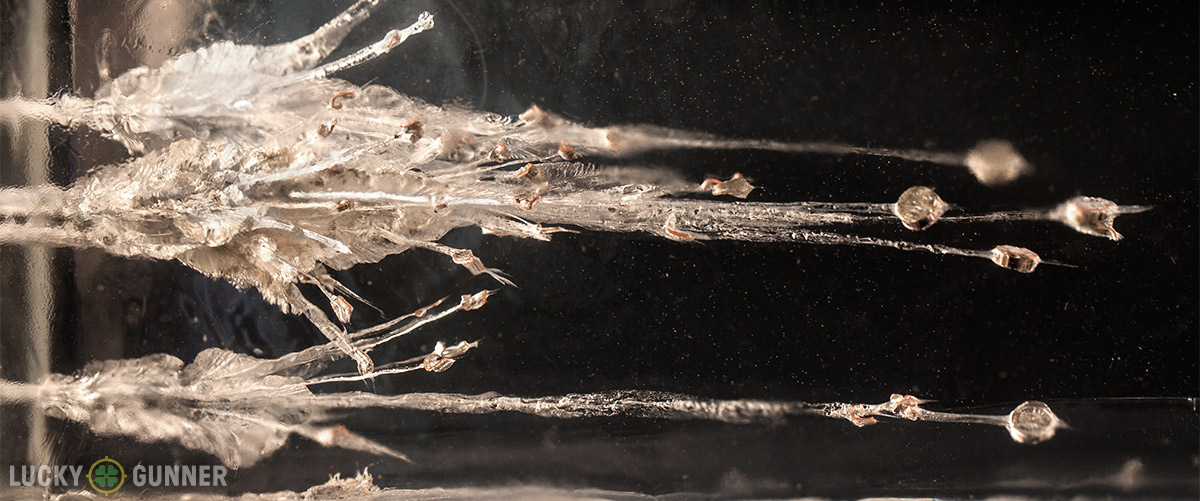
Because the vast majority of the tested loads exhibited 98% or better weight retention, we haven’t shown that data in our chart (although you can find that info on the individual product pages by clicking on the name of each load in the chart). Instead, we’ve used an asterisk on the chart to indicate the few loads that retained less than 85% of their original weight on average. Looking at the accompanying photos will clearly show whether the weight retention failure was due to fragmentation or core-jacket separation. The core-jacket separation issue tends to be more common when bullets encounter hard barriers such as windshield glass or car doors, and a bullet’s weight retention in our heavy clothing tests can’t be taken as an indicator of how the bullet would perform against other barriers.
Permanent vs. Temporary Wound Cavity
One final aspect of ballistics testing we haven’t yet addressed is the wound cavity — the flesh that is disrupted by the bullet. The permanent wound cavity is the “tunnel” made by the bullet that’s visible in all of the gelatin photos. Bullets that expand or tumble will leave a bigger wound cavity than bullets that fail to expand.
The temporary wound cavity can be seen in the high speed video footage when the gel balloons and stretches as the bullet enters. As cool as that looks, it can be misleading. The Clear Ballistics synthetic gel has more elastic properties than organic gelatin, so the temporary wounding effects tend to appear more dramatic and aren’t a very good representation of the effects on living tissue. Furthermore, most ballistics researchers believe the temporary cavity created by handgun ammo does not lead to any significant wounding effects. Rifle bullets travel at a much higher velocity and can create temporary wound cavities that tear and disrupt tissue not even touched by the bullet itself (sometimes called “hydrostatic shock”). Because handgun bullets typically travel at relatively low velocity, they possess little to no capacity to induce this phenomenon.
Generally, for handgun ammunition, only the permanent wound cavity should be considered to have any reliable effect on the target.
Ballistic Test Results
.380 ACP Ballistic Gelatin Tests
As expected, .380 ACP turned in the weakest overall performance of the four calibers we tested, but a few loads fared surprisingly well. Most loads showed either good penetration but no expansion, or decent expansion with sub-par penetration. Only a couple of loads managed to show decent numbers for both. There’s a reason that .380 ACP is often considered “underpowered”, but careful ammo selection can help to mitigate its deficiencies to some degree.
9mm Ballistic Gelatin Tests
There were several 9mm loads showing adequate penetration with a decent amount of expansion as well. Some of the loads became partially clogged with the heavy fabric which prevented complete expansion and led to slight over-penetration in the 18-22 inch range. Only a few loads completely failed to expand on all five shots, and the fragmenting bullets were among the few to fall shy of the FBI’s 12-inch penetration depth minimum.
.40 S&W Ballistic Gelatin Tests
Under-penetration was very uncommon for the .40 S&W loads. On the other hand, some of the bullets had trouble with the heavy clothing barrier, leading to expansion failure and penetration that exceeded the 32″ maximum depth of our dual gel-block setup. Many of the loads that did stay within the FBI 12-18″ range showed excellent expansion, sometimes nearly twice the original bullet diameter.
.45 ACP Ballistic Gelatin Tests
As with .40 S&W, some of the .45 ACP loads became clogged up in the heavy clothing and showed severe over-penetration, but the loads that expanded successfully did so with impressive results.
Conclusions
Looking at all of this data, it’s tempting to try to sift through the numbers and determine once and for all which load is The One Bullet To Rule Them All. If that kind of data analysis gets you excited, then go for it. If, on the other hand, you just want to find a decent load for your carry gun, you probably don’t need to go through all of that trouble. To the contrary, we did all of this work on these tests so you don’t have to obsess over the ballistic performance aspect of your carry ammo.
If the self-defense load you use is listed here, and you’re not confident in the results you’re seeing, just pick another one that performed at a level you’re more comfortable with. But keep in mind, even though the gelatin tests can tell us a lot, there’s plenty of things they don’t tell us. Ballistics testing doesn’t tell us anything about the felt recoil of a load. We also haven’t addressed accuracy or muzzle flash (which can be an issue in low light). And maybe most important of all, no gelatin test can tell you if a given load will run reliably in your own self-defense pistol. This is all stuff you’ll have to test on your own at the range with your gun.
Once you find a load that works, whatever you decide, try to keep all of this in perspective. Choice of caliber and bullet are not the most important aspects of successful self-defense. Awareness, proper mindset, marksmanship, and discernment of when to use your firearm are generally far more critical to your survival than choice of gear. Having said that, knowing your carry ammo works not only provides peace of mind, there’s a chance that choosing a solid defensive load could be the one factor that tips the scales in your favor in a fight for your life.
******************************************************************************
As you can see from the article, not only did they do a large amount of testing, but they also have difficultly with spell check and grammar……
SERIOUSLY THOUGH:
I find it interesting that the testing is all done with certain “known variables” used as a basis of lethality. Such “known variables” are the 12″ (or 16″ in this article’s case) regarding ability to reach vital organs. I understand that there has to be some sort of baseline, but the whole idea that your bullet has to penetrate a certain distance to supposedly be more lethal only makes sense in certain instances. Let’s use the 3 main ways weapon systems take down an animal while hunting: exsanguination (bleeding out), hydrostatic shock, and penetration (big bore calibres). The fact that I used hunting as a baseline is because it is a tangible, viable and understandable way to show examples of how these 3 ways projectiles harvest animals.
Exsanguination takes place when you use a cutting type instrument like an arrow. If you have never bow hunted or seen an animal hit with an arrow, I suggest you examine this before you EVER consider getting into a discussion about stopping power or bullet effectiveness. The fact that my 4 blade Muzzy broadheads will put a hole bigger than my thumb all the way through a deer when shot at 30 yards is just amazing. The deer travel about 20-30 yards and expire. I know that any solid shot will allow me to find my animal less than 40 yards distance from site of impact. This is very common with properly placed shots with a bow and a broadhead designed to leave large wound channel. The results may be different depending on the broadheads used, but there is a common theme where the animal expires within a short distance due to the large, bleeding wound channel.
Hydrostatic shock is where the energy from the bullet is transferred to surrounding tissue and damage occurs due to this “shock.” If you have ever field dressed an animal and found that jelly like tissue throughout the wound channel, you know first hand what damage hydrostatic shock does. It makes the tissue no longer “viable” and thus causes the animal to expire due to that damage. A great example of this would be the deer my father harvested this last weekend. Although he missed the deer’s heart, one ventricle was ruptured and the other one was damaged enough from hydrostatic shock to have completely turned into jelly of sorts. Both lungs where also a mush and unusable. His animal ran about 50 yards and expired. Those that hunt with high power firearms understand and have seen that damage.
Big bore bullets literally poke a hole all the way through an animal. Expiration can be due to damage to internal organs, thus causing exsanguination or even complications such as pneumothorax where air enters the chest cavity and the lungs/heart no longer function properly. There is a degree of hydrostatic shock from the bullet pushing its way through the animal. The best way to imagine this type damage, however, is to image a sledge hammer being shoved through an animal. The sledge hammer isn’t going to be going as fast as many rifle calibres, but the damage is going to be remarkable.
What a lot of these tests don’t measure is the combination of damage that can be done. For example, the use of a hollow point bullet can cause a lot of hydrostatic shock. It can also do a lot of damage that can cause exsanguination if the round was fired into certain vital areas of the body. At the same time, a large calibre bullet being fired into tissue can also act like a big bore firearm at times. Organs can be literally punctured with a large hole that can cause this type of penetration damage.
The conclusion of this article is actually quite good. It simply tells you to use what you like, what seems to work and be competent in your abilities above all. “Awareness, proper mindset, marksmanship, and discernment of when to use your firearm are generally far more critical to your survival than choice of gear.” (Baker, 2015)
So in closing I will just say this: You should use whatever you WILL carry or CAN shoot well rather than what someone else tells you is best. If your full sized Glock is sitting in your nightstand because you are tired of it pulling your britches down, you have already lost the battle and have no real dog in the fight. Keep that in mind when other people talk. Chances are that their “carry gun” is sitting in their truck and not on their belt.



